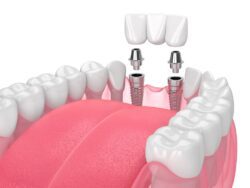Your dentist can help you improve the appearance, function, and health of your smile after tooth loss through restorative dental solutions. You can achieve maximum benefits from tooth replacement with implant dentistry. These fixtures can replace one, several, or an entire arch of missing teeth depending on your unique oral health goals.
You can feel more confident about pursuing this fixed and permanent tooth replacement treatment when you know more about these devices. Your dentist will explain details about your specific treatment plan during a consultation appointment. But you can also learn more about each component that makes up a dental implant by reading on.

Implanted Anchor
Implant dentistry begins with the first element of the device: a titanium post anchor. The dentist will surgically place this anchor into the jaw where it will fuse with the jawbone as it heals. This creates an extremely strong foundation that will support the rest of the implant.
Your dentist can insert as many anchors as needed within one oral surgery to support the type of implant that you require. The fusion and recovery process will take several months to complete. But you can anticipate a week or so of downtime as you heal from this initial procedure.
Because the implant relies on this anchor fusion process, you must have enough healthy jawbone to sustain the device. A dentist will evaluate your jaw health with x-ray imaging prior to beginning treatment. If the implant feels loose or severely painful, let your dentist know because these symptoms are abnormal and could indicate a problem with the device.
Abutment Piece
Your dental implant will feature a metal connective piece called an abutment that attaches to the top of the anchor. This device serves to establish a stronger link between the anchor below the gumline and the prosthetic teeth that will sit above the gums.
The abutment keeps the implant even more securely in place in your mouth. This way, you can approach eating, speaking, and other oral functions with confidence. You will not have to worry about your appliance slipping out of place at an inopportune moment.
Prosthetic Teeth
After the anchor fuses into place, you will return to your dentist to receive your custom-made prosthetic teeth. The dentist may give you a crown, bridge, or set of dentures in order to fully restore your smile.
They build them on a personalized basis for each patient in order to provide a color, size, and shape to the teeth that suit their unique smile. And the dentist will consider both your oral health goals and your desired results when it comes to smile aesthetics.
The ceramic material of these prosthetic teeth will resist staining so that you can enjoy their gorgeous appearance for as long as possible. And they are durable so that you can perform oral functions without worrying about hurting the fixtures. Dental implants can stay in place in your smile for twenty years with proper maintenance.
